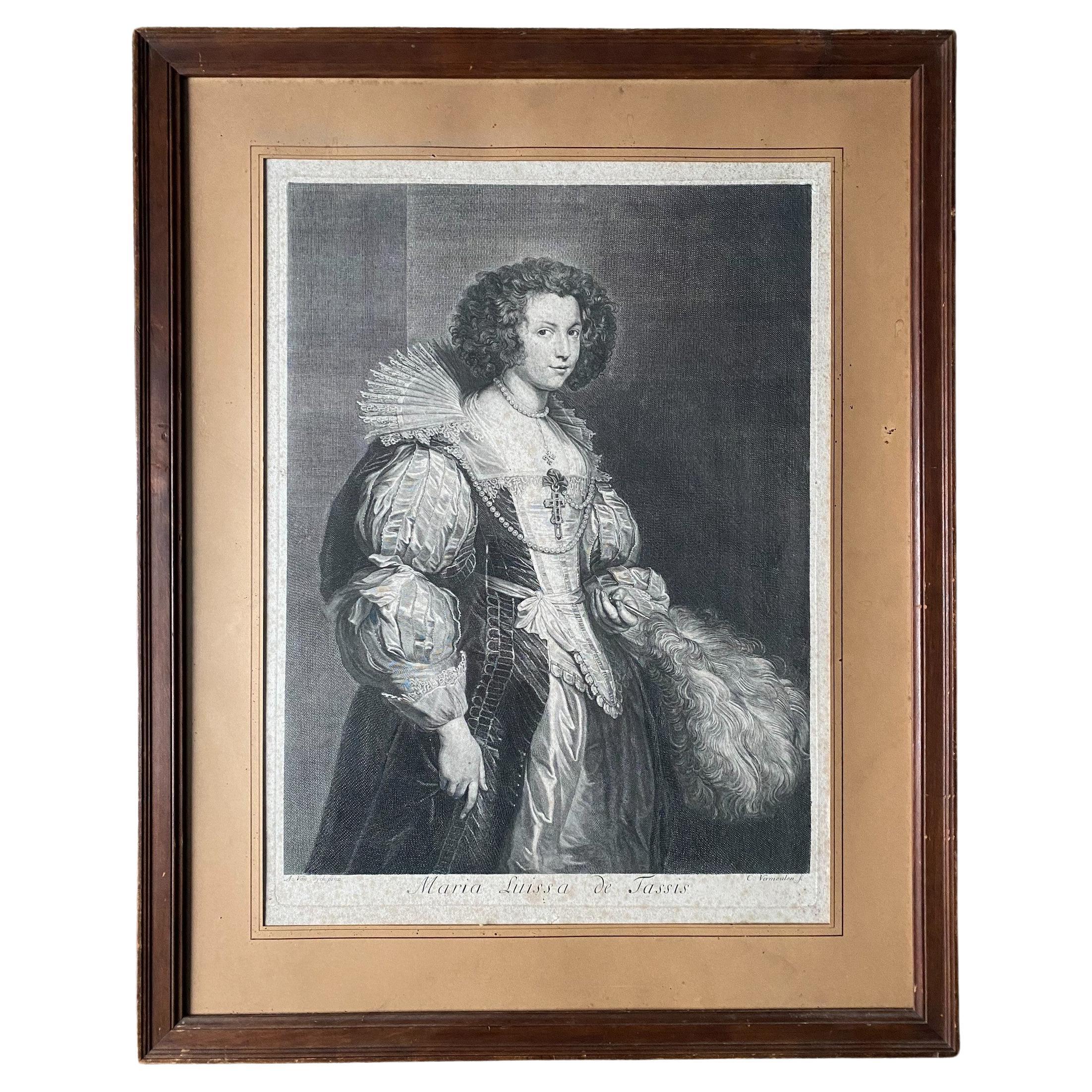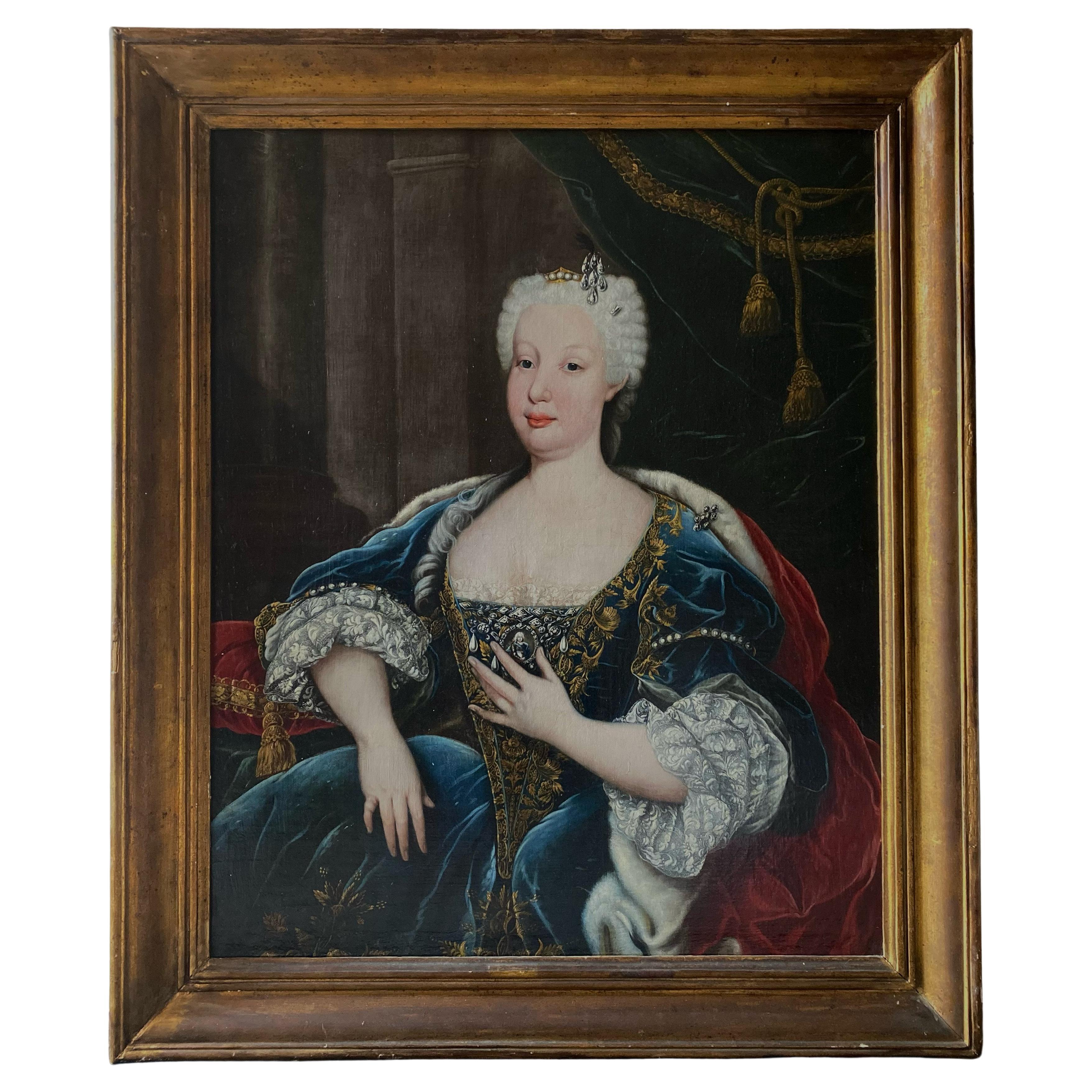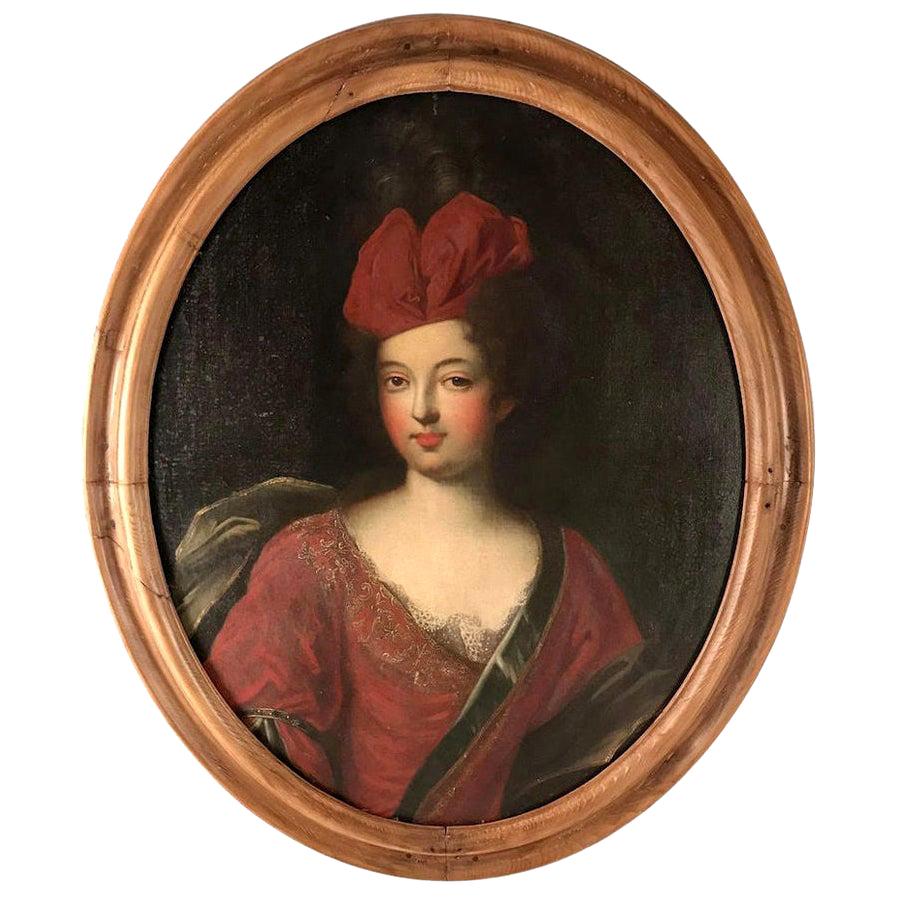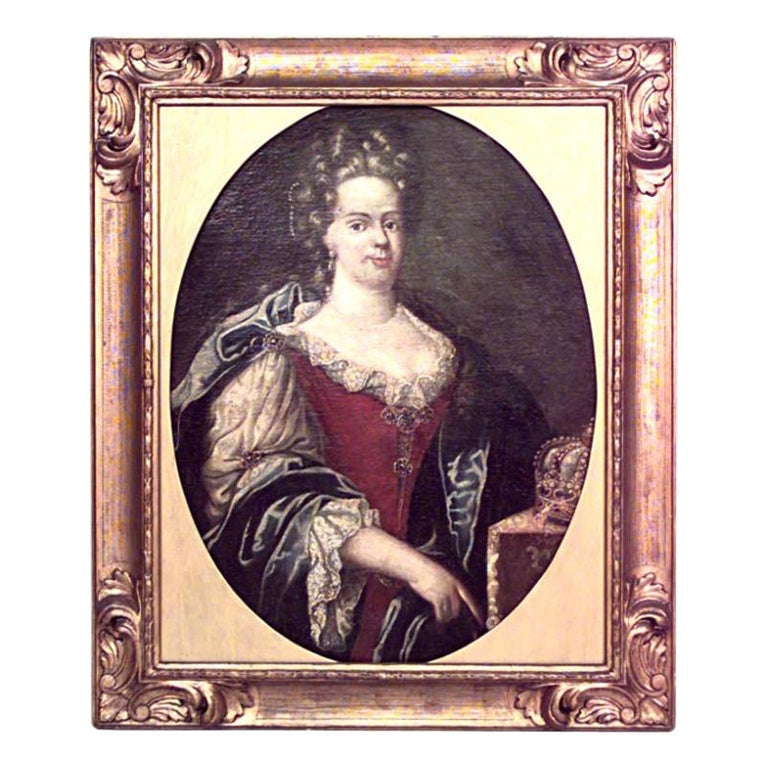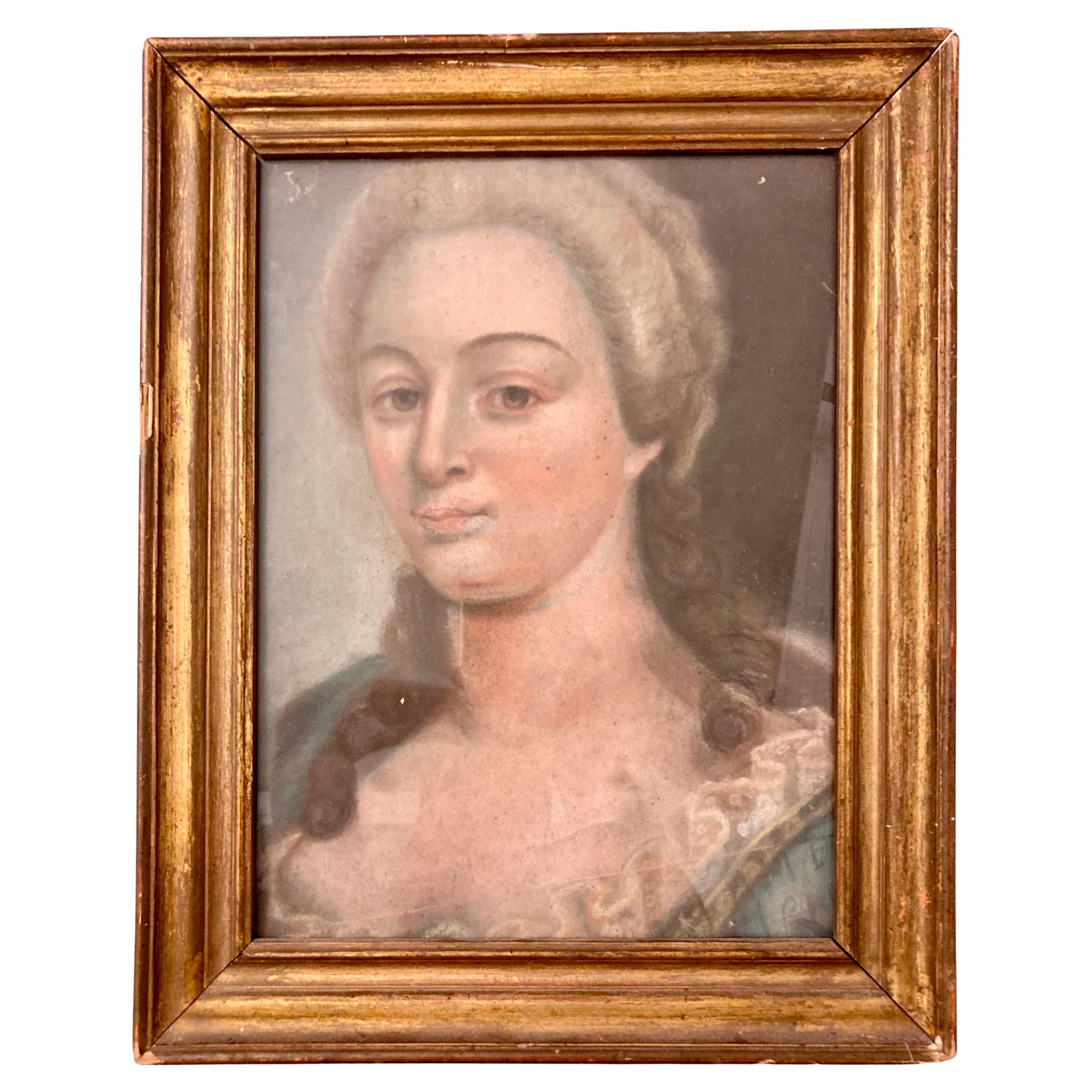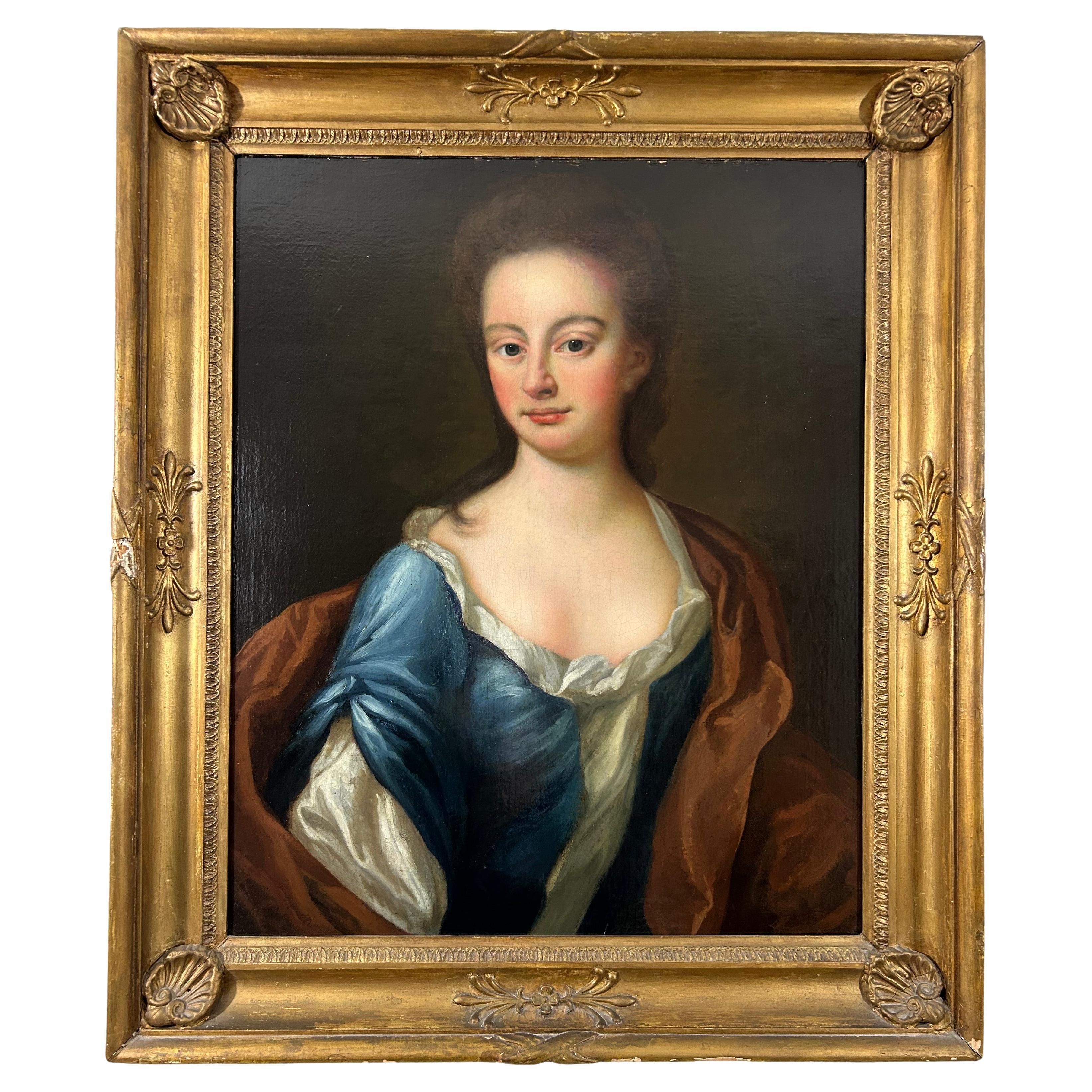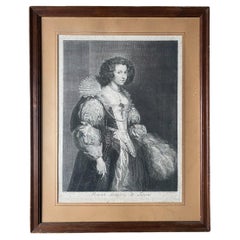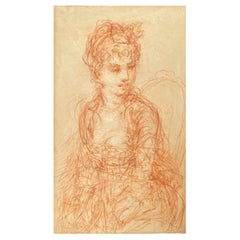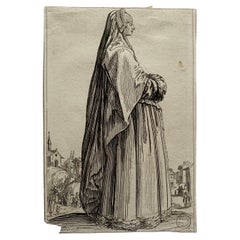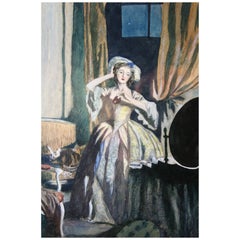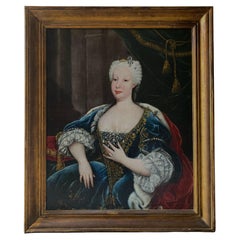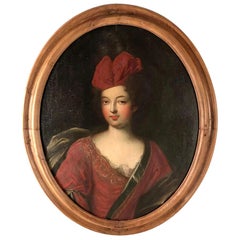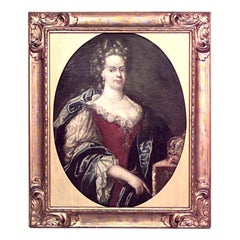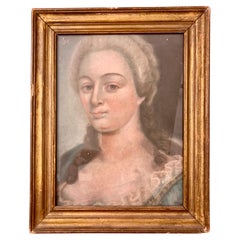Items Similar to RIGAUD (after) - 19th Drawing signed Portrait of Marie Nemours Orleans - France
Want more images or videos?
Request additional images or videos from the seller
1 of 13
RIGAUD (after) - 19th Drawing signed Portrait of Marie Nemours Orleans - France
$1,011.91
£752.12
€850
CA$1,397.17
A$1,549.36
CHF 814.07
MX$18,930.51
NOK 10,185.15
SEK 9,560.51
DKK 6,472.32
About the Item
Superb, rare and large drawing representing a Portrait of Marie d'Orléans-Longueville, Duchess of Nemours, Princess of France.
The drawing is perfectly done. Wonderful work of light on the lace in particular which seems to come out of the painting thanks to its bluish tint. The shadow play is magnificent.
On thick marked paper.
Drawing Dated 1891 and signed.
The Signature is probably “Sieur Duval”.
Very good Made from the magnificent painting by Hyacinthe Rigaud (1659-1743), painter of the 18th century model dated 1707.
The engraver Pierre Drevet (1663-1738) also engraved this work.
The work is “Mary by the grace of God, sovereign of Neufchâtel and Vallangin, duchess of Nemours” / « Marie par la grâce de Dieu, souveraine de Neufchâtel et Vallangin, duchesse de Nemours »
Description of the work: Half-legged, seated, turned three-quarters to the left, looking straight on, the princess, whose left arm is folded across her chest, holds her crown placed on the table with her right hand. She is dressed in dark court attire, her head covered with a headdress whose tails are tied on the chest. A curtain and the base of a column constituting the second plan.
Marie de Nemours, born in 1625 and died on June 16, 1707, is sovereign princess of Neuchâtel and Valangin. Daughter of Henri II of Orléans-Longueville and Louise de Bourbon-Condé, Mademoiselle de Soissons, she was known until her marriage under the name Marie d'Orléans, Mademoiselle de Longueville.
Marie d'Orléans, only daughter of the Duke of Bourbon and Longueville, married Henri II of Savoy, last Duke of Nemours, in 1657. The court was surprised that the richest heiress in France agreed to marry this duke without possessions and without consideration, staid and boring. The Duke of Nemours suddenly fell ill and died on January 2, 1659. The Duchess of Nemours survived him for a long time. In 1694, she was recognized as sovereign of the principality of Neuchâtel and Vallangin (Switzerland), by the states of the country, to the exclusion of the Prince of Conti. She died in Paris on June 16, 1707, at the age of 82. Five months later, despite claims of misconduct by the suitors, the court of these same states awarded this small sovereignty to the King of Prussia. The Duchess of Nemours was said to be miserly and carefully hid her rank under cheap clothes. She was devout but suspicious and often changed her confessor. She left Memoirs, recognized to be remarkable for their accuracy, fidelity and charm of style.
Hyacinthe Rigaud, famous painter to King Louis XIV, was born in 1659 and died in 1743.
He was the major portraitist of the king and his Court at Versailles. Rigaud fixed for three centuries the image of the official portrait of European courts.
On the advice of Le Brun, he devoted himself to portraiture, a genre which he elevated to its highest expression. He attracted the attention of the king and the Court with the portrait of Monsieur, brother of the sovereign, in 1688 then of Philippe II of Orléans, the following year. Louis A true emblem of the French monarchy, it definitively freezes the image of the camera portrait: column and landscape in the background, shimmering drapery, solemn pose, intense colors. French and European sovereigns continued to be portrayed in this way until the 19th century. Rigaud repeats his performance for Louis XV in 1730.
- Similar to:Hyacinthe Rigaud 1 (Painter)
- Dimensions:Height: 18.51 in (47 cm)Width: 15.36 in (39 cm)Depth: 0.04 in (1 mm)
- Style:Louis XIV (In the Style Of)
- Materials and Techniques:
- Place of Origin:
- Period:
- Date of Manufacture:1891
- Condition:Wear consistent with age and use.
- Seller Location:Beuzevillette, FR
- Reference Number:1stDibs: LU2663336025762
About the Seller
4.9
Vetted Professional Seller
Every seller passes strict standards for authenticity and reliability
Established in 2010
1stDibs seller since 2017
300 sales on 1stDibs
Typical response time: 5 hours
- ShippingRetrieving quote...Shipping from: Beuzevillette, France
- Return Policy
Authenticity Guarantee
In the unlikely event there’s an issue with an item’s authenticity, contact us within 1 year for a full refund. DetailsMoney-Back Guarantee
If your item is not as described, is damaged in transit, or does not arrive, contact us within 7 days for a full refund. Details24-Hour Cancellation
You have a 24-hour grace period in which to reconsider your purchase, with no questions asked.Vetted Professional Sellers
Our world-class sellers must adhere to strict standards for service and quality, maintaining the integrity of our listings.Price-Match Guarantee
If you find that a seller listed the same item for a lower price elsewhere, we’ll match it.Trusted Global Delivery
Our best-in-class carrier network provides specialized shipping options worldwide, including custom delivery.More From This Seller
View AllA. Van Dyck "Maria Luissa De Tassis" Engraving by C. Vermeulen 17th Century
By Corneille Vermeulen
Located in Beuzevillette, FR
This magnificent etching is a portrait of "Maria Luissa de Tassis", engraved by C. Vermeulen after the painting by A. Van Dyck of 1630. Van Dyck painted in 1630.
Antoine Van Dyck, ...
Category
Antique 17th Century Belgian Prints
Materials
Paper
Sanguine Portrait of a Woman Napoleon I Period Early 19th Century
Located in Beuzevillette, FR
Charming red chalk study of a woman from the First Empire period, 19th century. Study of a woman in elegant costume typical of the Napoleon I period, sitting on a chair and turned 3/...
Category
Antique Early 19th Century Drawings
Materials
Paper
Jacques Callot "La Dame en deuil" Engraving 17th Century
By Jacques Callot
Located in Beuzevillette, FR
This engraving is part of a series of 12 plates called "La Noblesse" ("Nobility"). Numbered 5, it was published with the 11 others between 1620 and 1623. It depicts a lady wearing a ...
Category
Antique 17th Century French Louis XIII Prints
Materials
Paper
French painting « the Masquerade » , 19th Century - Louis XV style
Located in Beuzevillette, FR
Beautiful painting representing a woman of the XVIIIth century. The scene is set in a typical interior of the period, recognisable by the furniture, armchair and bench in the Louis X...
Category
Antique 19th Century French Drawings
Materials
Paper
Jacques Renaud Bernard, Set of 5 Engraving of Architecture, 18th Century
Located in Beuzevillette, FR
Beautiful set of 5 engravings by Jacques Renaud Bernard representing the parade hall and the apartments of the Duchess of Orleans at the Royal Palace in Paris, architectural ensemble designed by the architect of Louis XV Pierre Contant D'Ivry. The engravings represent the architectural details of the different rooms (moldings, sculptures, furniture etc.) This set of engravings...
Category
Antique Late 18th Century French Louis XVI Picture Frames
Materials
Paper
Jacques-Philippe Le Bas "The Illumination" Engraving 18th Century
By Jacques-Philippe Le Bas
Located in Beuzevillette, FR
Interesting engraving by Jacques-Philippe Le Bas depicts the illuminations set up on the evening of 29 August 1739 at the crossroads of St Denys and La Ferronnerie for the wedding of...
Category
Antique 18th Century European Prints
Materials
Paper
You May Also Like
Portrait of D. Maria Bárbara De Bragança, Circle of Louis-Michel Van Loo
By H. van Loon
Located in Lisboa, PT
PORTRAIT OF D. MARIA BÁRBARA DE BRAGANÇA (1711-1758), QUEEN OF SPAIN
Circle of Louis-Michel van Loo (1707-1771)
Oil on canvas
Her Royal Highness, the Infanta Maria Barbara of Braganza (1711-1758) was the first-born child of King John V of Portugal (1689-1750) and his queen consort Maria Anna of Austria (1683-1754). Born in December 1711, she had the Convent Palace of Mafra built in her honour following a vow made by her royal father. Her status as Princess of Brazil, inherent to 18th century Portuguese presumptive heirs, would however be superseded once the queen gave birth to two male princes, D. Pedro (1712-1714) and D. José (1714-1777), preventing her from ascending to the throne.
Daughter of one of the most illustrious monarchs of his time, Maria Barbara was carefully educated to become a fond admirer of the arts, and of music in particular, having had the Italian composer Domenico Scarlatti (1685-1757) as her music teacher.
On the 10th January 1723 the young princess was betrothed to the Infante Ferdinand of Spain (1713-1759), eldest son of King Philip V (1683-1746). Six years later, on the 19th January, she entered her new country in a carefully choreographed ceremony that became known to history as the “Exchange of the Princesses”. This unique event took place on a specially built Bridge-Palace, a wooden, luxuriously decorated structure that included various modules and rooms, on both banks of the river Caia, the natural border between the town of Elvas in Portugal and of Badajoz in Spain. Simultaneously, on the same day that the Portuguese Infanta crossed the border to marry the Spanish Crown Prince, her new sister in law, the Infanta Mariana Victoria of Bourbon (1718-1781), her husband’s sister, crossed the same bridge in the opposite direction to marry Prince D. José, the Portuguese heir to the throne.
Once married, Maria Barbara would spend 17 years as Princess of Asturias, only becoming Queen of Spain at her husband’s accession following the death of Philip V in 1746. She is portrayed in the 1743 painting by Louis-Michel van Loo (1707-1771) now in the Prado Museum, in which Philip V had himself represented with all his close family.
The new Queen would take an important role at court eventually becoming the liaison between her husband and the King of Portugal, particularly throughout the negotiations for the Treaty of Madrid (1746-1750). Maintaining her interest in music, she patronized the Italian castrato singer Farinelli (1705-1782) while remaining close to her old master Scarlatti, having herself composed some sonatas for a large orchestra. She would also commission and fund the building of the Royal Salesians Monastery complex in central Madrid, where both her and Ferdinand VI are buried.
The portrait we are presenting for sale shows the Queen in half-length, turning left at three quarters. She is wearing a blue low-cut dress embroidered with flowers and foliage, over a lace cuffed white blouse, and an ermine cloak pined on the left-hand side by a diamond broach. The powdered hair style is held sideways by a seven diamond and black plume headdress and topped by a small gold and pearl crown. The right arm rests on a cushion while the left hand, at chest height, holds a miniature male portrait.
The Infanta’s features are analogous to the 1725 portrait by the painter Domenico Duprà (1689-1770), also in the Prado Museum collection. Further similarities can be found in another portrait by Louis-Michel van Loo, in which a seven diamond and black plume headdress is also present. In this work, the cushion supporting Maria Barbara’s right arm has also some obvious similarities to our painting. The same diamond headdress reappears in Van Loo’s above-mentioned portrait of Philip V’s family dated from 1743.
It is nevertheless in Lisbon’s Ajuda National Palace that it is possible to find an almost identical depiction of the Infanta holding a miniature portrait of her husband. In it, the future Ferdinand VI is portrayed facing right at three quarters and wearing a curly wig, suit of armour, the golden fleece insignia and a blue band, in a composition that closely resembles an 18th century Spanish school painting that appeared in the art market in January 2016.
Another detail common to various portraits of the Portuguese Infanta and Queen of Spain is the small gold and pearl crown on her head. In another Van Loo painting, also from the Prado Museum, in which Maria Barbara is portrayed as Queen, this crown is represented together with a headdress similar to the one previously described. Another two paintings by the same artist, at the Royal Academy of Saint Ferdinand, include the same ornament.
We must also refer the paintings by the artist Jean Ranc (1674-1735). In one, dating from 1729 (Prado Museum), the Infanta is depicted outdoors holding a flower bouquet and wearing a yellow silk dress with red cloak, and a set of diamond and ruby jewellery that includes a headdress similar to the one present in our portrait. Another work by the same artist, belonging to the Complutence University of Madrid, depicts the Infanta sumptuously dressed in identical colours to our painting and wearing an elaborate headdress and diadem.
These portraits, beyond their iconographical importance as contemporary records of the Infanta and Queen Maria Barbara, are also illustrative of 18th century fashion for jewelled head dressing. Often, flowers were combined with joyful adornments, composing almost theatrical displays that would reinforce the ostentatious nature of the image. The ornamental flowers and the chromatic character of the jewels would complement the luxury of the colourful dresses in blue, crimson, green or other silk shades, in compositions whose sole purpose was to highlight a royal sitter’s wealth and power, becoming an essential statement accessory within the strict court protocols and codes of conduct.
Circle of Louis-Michel van Loo (1707-1771)
Slowly but steadily, the resolute, tranquil and dignified attitude of Renaissance and Baroque portraiture becomes artificial and presumptuous. Mid 18th century society favours elusive expression and psychological deepness, albeit limited to the face, that, with emphasis on detail, on the rich colour palette and on changing costumes and landscapes, associated to the courtliness of gestures, creates a strongly artificial environment while maintaining a highly poetic intrinsic character.
Louis-Michel van Loo followed a dynasty of famous Dutch origin artists that had settled in France. Initially taught by his father, Jean-Baptiste von Loo (1684-1745), the younger van Loo studied in Turin and Rome and frequented the Paris Academy. In Rome he worked with his uncle Charles-André van Loo (1705-1765) and become a painter for the Turin Court. In 1737 he arrived in Spain being summoned by Philip V to succeed Jean Ranc as painter of the king’s chamber.
In Madrid, his work covers the numerous Court commissions and the Royal Saint Ferdinand Fine Arts Academy, of which he was a founding member and director for the Painting department in 1752. Is production at court consisted essentially of numerous portrait paintings, often Royal gifts...
Category
Antique 18th Century Spanish Baroque Paintings
Materials
Canvas
Late 17th Century Oil Portrait of a Lady
Located in Lymington, GB
An oil on canvas portrait of a young French courtier, circa 1690.
This evocative antique French-school picture has been attributed to the portrait painter Jean-François de Troy (1679-1752).
De Troy was famous as a portrait painter of fashionable society women.
This is a very attractive late-17th century painting surviving in its original frame and stretcher. The canvas appears to be untouched.
References:
'Jean François de Troy, The Alarm, or the Gouvernante Fidèle', at the Victoria and Albert Museum, London.
'Jean François de Troy, Paris 1679 - Rome 1752', at the Thyssen-Bornemisza Museum.
Laurie G. Winters, Troy, de, Grove Art Online, Oxford Art Online, Oxford University Press, 6 May 2016.
Everett Fahy & Jayne Wrightsman...
Category
Antique 17th Century French Paintings
Materials
Canvas
French Louis XVI Crowned Lady Portrait
Located in Queens, NY
French Louis XVI style (18th Cent) gilt framed oval oil painting portrait of lady wearing crown
Category
Antique 18th Century French Louis XVI Paintings
Materials
Paint
French 18th Century Pastel Drawing Portrait of a Lady
Located in Los Angeles, CA
French 18th Century pastel portrait drawing of a lady. Beautiful details and gorgeous old gilt frame. Glass is old with bubbles. Add some classic French style to your home.
Category
Antique Early 18th Century French Provincial Paintings
Materials
Canvas
Early Nineteenth Century Portrait of a Lady
Located in Toronto, CA
A stunning oil portrait in the manner of Allan Ramsay, a Scottish painter who was renowned for his portraits in the 18th century. (1813-1784) This is a beautifully executed painting...
Category
Antique Early 19th Century British Baroque Paintings
Materials
Canvas, Wood
18th-Century Dated Drawing – Portrait of a Young Woman (May 6, 1780-70?)
Located in Madrid, ES
An intriguing 18th-century drawing, dated May 6, 1780 (or possibly 1770). This delicate artwork depicts the portrait of a young woman, executed with exceptional skill and attention t...
Category
Antique Late 18th Century Drawings
Materials
Paper
More Ways To Browse
Antique Sovereigns
King Louis Xiv
Le Brun
De Grace
Fold Chest
18th Century Flemish Verdure Tapestry
18th Century Hinges
18th Century Japanned Box
19th Century Erotic Art
1910 Stained Glass
1950s Display Cabinet
19th Century Diorama
19th Chinese Carved Dragon
3 Tier Stand Vintage
Acanthus Leaf Table
Admiral Portrait
African Carved Animals
African Wall Hanging
